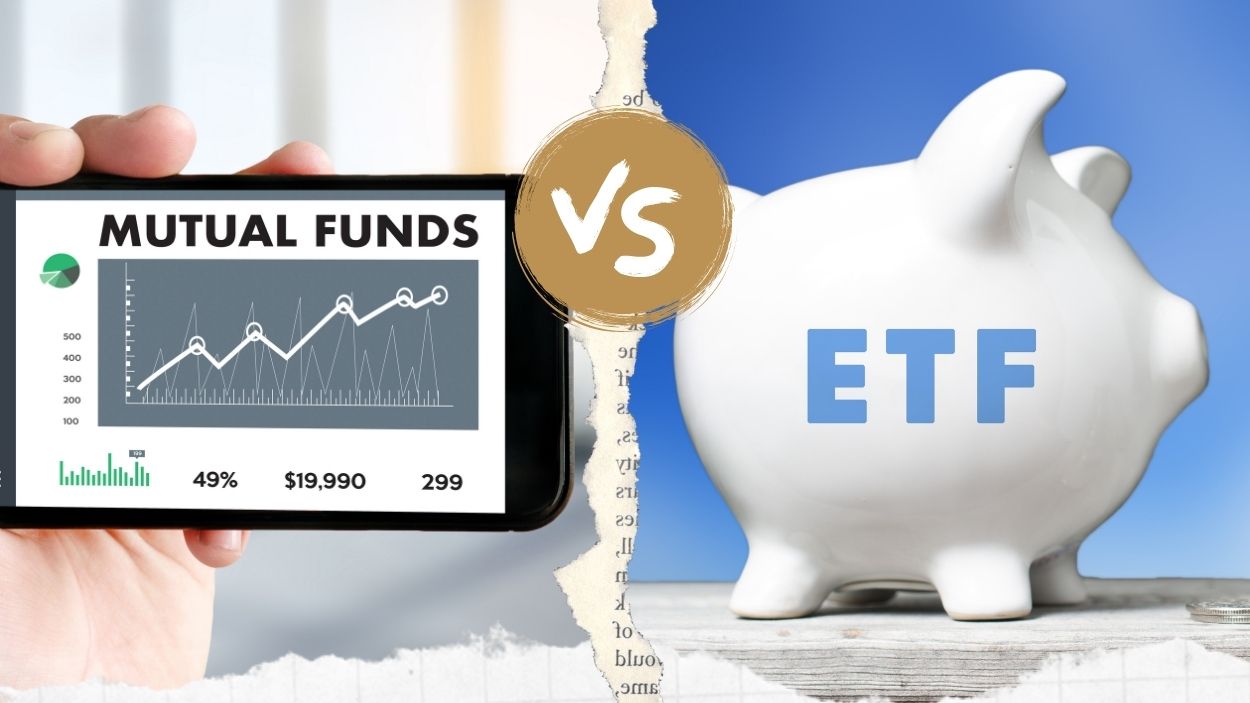Mutual funds and ETFs are similar, but there are important Difference between ETF and Mutual Funds that we should aware of. There are two ways to figure out which one is “better.”
- What kind of investor you are?
- What kind of investing you want to do?
ETFs and mutual funds: which is better for you?
Both ETFs and mutual funds are like baskets of different stocks, bonds, or other assets. But the assets in a mutual fund have been chosen and managed by a fund manager. It will cost more to use.
ETFs (exchange-traded funds) are like baskets: they have a lot of different stocks, bonds, or other assets in them, depending on the ETF. There is a risk that you could lose money if you pick individual stocks, but this lets you invest in a lot of different parts of the market without having to spend a lot of time and money on that. Because ETFs invest in fractional shares of companies, they let you participate in the market without paying for individual shares. This is because ETFs invest in fractional shares, which are cheaper than whole shares.
In general, ETFs don’t need to be managed by humans. So they don’t have high management expense ratios (MERs).
Like ETFs, mutual funds are like baskets of different stocks, bonds, or other assets. But the assets in a mutual fund have been chosen and managed by a fund manager. That means that a mutual fund is actively managed, which means that it will cost more to use.
Difference between ETF and Mutual Funds:
One of the main differences between mutual funds and ETFs is that mutual trade once a day at the end of the day. That’s important because a stock (or a group of stocks) in a mutual fund might rise and fall during the day, but at the end of the day, that’s the price you’re stuck with, good or bad.
There are ETFs that trade all day long. Actively managing ETFs (or having someone else actively manage them for you) means you can react to changes in prices all day long. Let’s say you think an ETF is going to rise during the day, so you could buy an ETF early in the day and make money when it goes up. But ETFs are just like any other asset and can change in value during the day, both positive and negative.
Expense ratios for managing Mutual funds and ETFs
As we’ve already talked about in this lesson, cost is a big factor for people who are deciding whether to invest in ETFs or mutual funds. ETFs are more cost-effective because they have low MERs. ETFs are usually traded for free, and because they’re not actively managed, which means there isn’t a person in charge of them, there aren’t any fees for trading or for managing them.
The ETFs are usually thought of as “passive” assets, which are investments that are made using the “set-it-and-forget-it” method of investing. You set a budget for how much money you want to put into your ETFs at set times each month, and then you leave it alone. Your ETFs will make it more likely that your investments will grow at a steady rate that mirrors the growth of the market. This “let it go” attitude also means lower fees for you.
In the long run, active investing has a big advantage. If you want to keep a close eye on how your money is being invested, then a mutual fund will be a better choice for you than an ETF. They build their portfolios around a specific goal or strategy that they’ll work hard to achieve. ETFs, on the other hand, are more likely to just mirror the markets they’re based on. Also, mutual funds give you more control over what kinds of assets are in the fund. ETFs, on the other hand, tend to be more diverse.
Capital Gains
Some mutual funds may make money each year if they sell their investments at different times during the year. Capital gains tax will be due in the year that you get the money, even though that’s great.
An ETF, on the other hand, isn’t likely to make capital gains, so they’re thought to be more tax-efficient.
Similarities between ETFs and mutual
Diversification
Most of the things that make an ETF and a mutual fund alike are that they both come with built-in diversification. Because they each bundle together a lot of different assets, like stocks, bonds, and other securities, they give investors access to a large part of the market. This is good if you don’t have the money, time, energy, or risk tolerance to pick out individual stocks.
Diversification also has a lot of great benefits. There is less risk. Putting your eggs in a lot of baskets is less risky than putting your whole life savings into one or two stocks.
There are both good and bad things about mutual funds and ETFs, so let’s look at them.
A lot of people know now that each fund can be useful in a different way depending on what kind of investor they are as well as what they want to get out of their money. Here are the pros and cons of each one:
Mutual funds
Pros
- Fund managers actively manage mutual funds. Mutual funds have a specific goal or strategy, they tend to give investors more choices about what kinds of securities are in the fund, which is good for them.
- Mutual funds are usually actively managed. This means that you’ll get a lot of help from your funds’ fund manager and their research staff.
- Long term wealth generation.
Cons
- All of expenses and other costs can eat away at your profits. Be sure not to lose money when you invest in a mutual fund.
- Mutual funds also tend to have higher minimum investment limit, which could be a turn-off for new investors or those on a tight budget.
- It can be more risky to invest in an actively managed fund because the managers are trying to “beat” the market instead of just mirroring it. This can put you at risk of losing money.
ETFs
Pros
- ETFs are usually not actively managed. Usually ETFs have lower management fees and lower investment minimums because of this. This makes them very easy to use for newbies and people who are on a tight budget.
- It’s ideal for people who don’t want to do anything.
- Because ETFs are low-cost and low-risk, robo-advisors use them all the time.
- ETFs don’t try to beat the market might be a good thing. In the long run, some people think that a strategy that mirrors market indexes instead of trying to beat them may be more stable.
Cons
- You can’t really sell the single assets in an ETF.
- Not good for short-term strategies. There are a lot of ETFs out there that try to mirror the markets, so you’re more likely to lose money if you only keep your assets for a short time, like five years or less. Even if the market doesn’t change, that makes you more vulnerable to it, too. To get your money quickly, you might want to think about something like a high-interest savings account.
Keep your financial goals and level of comfort in mind when you choose a type of fund. This talk about diversification and ETFs might make you want to start investing right now. Before investing we should know about difference between ETF and Mutual Funds.
Also Read
What is An ETF & How to Invest in Exchange Traded Funds


